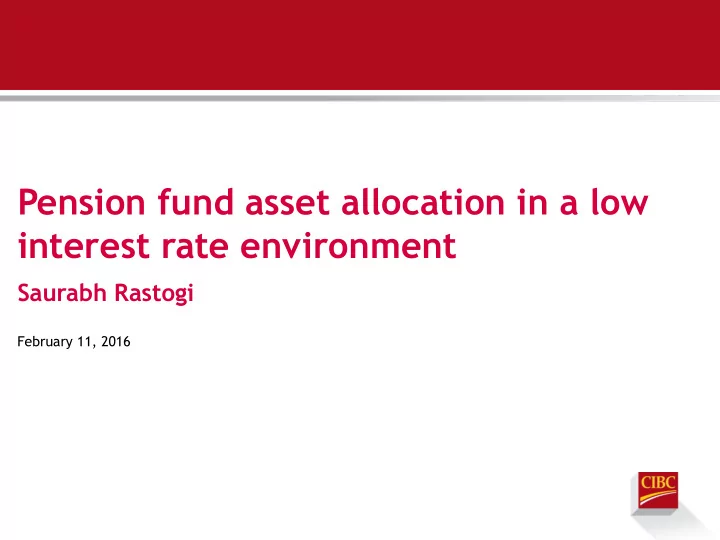

Pension fund asset allocation in a low interest rate environment Saurabh Rastogi February 11, 2016
1 Overview: CIBC’s Global Pension Plan Structure
2 Overview: CIBC Pension Plan • The bank’s principal plan is the CIBC Pension Plan which accounts for around 90% of the bank’s total pension plan assets and liabilities The CIBC Pension Plan is a Defined Benefit (DB) plan so the bank bears all investment risk • associated with fulfilling the pension promise to members • To secure the pension promise the plan is funded and as at October 31, 2015 the plan showed a surplus of approx. $300MM (see CIBC financial disclosures) • The assets of the plan are invested across a diversified portfolio comprising of equity and debt securities in both public an private markets The October 31, 2015 asset allocation versus the long term strategic target allocation is shown below: •
3 Pension Accounting • Since 2013 the quarterly change in the marked-to- market (MTM) value of the bank’s pension plans has been reflected on the balance sheet Changes in the MTM position of the plan are recognized through Other Comprehensive Income (OCI) • • OCI is a component of the bank’s Tier 1 capital and MTM volatility from the pension plans is therefore a source of Tier 1 Capital volatility to the bank Bank Pension Accounting rules Balance Sheet Mark to Market $ Assets Liabilities Equity
4 Tier 1 Capital Asymmetry • Basel III does not permit the inclusion of pension plan surplus in Tier 1 Capital Consequently any pension plan surplus is removed from Tier 1 Capital creating an asymmetric risk to • the bank • When the pension plans are in surplus, the impact of losses to Tier 1 Capital are non-existent as losses are offset by a reduction in surplus deduction • When the plans are in a deficit, however, the impacts can be potentially large • No other portfolio in our bank exhibits this asymmetry or has natural characteristics that can replicate or naturally offset this asymmetry
5 Low Returns are Baked In… Source: Bloomberg
6 Low Returns are Baked In… 40% Bonds 60% Stocks 70% Bonds 30% Stocks • Projected returns are lowest outside the late 90s TMT bubble. Source: http://www.hussmanfunds.com/rsi/policyportfolio.htm
7 Implications of Low Expected Returns Rising capital volatility from the pension plan • Low expected return levels would lead to quarters where we have negative impacts on capital • • Understanding of liability cash flow profiles become extremely important • What is liquidity worth to us? Management of the plan needs to change • Enhancing our tool kit • • Constant review of exposures • Increased frequency of A-L studies • Developing a holistic approach
8 What returns do we need? • The traditional approach to modeling liabilities takes into account accrued benefits only As accrued benefits are ‘fixed’ in the future, the value of assets required today to honour these benefits depends on the • asset return received in the future Accrued Benefits Accrued Benefits x.xx% p.a. Required Return x.xx% p.a. Required Return • Meets accrued cash flows • Meets accrued cash flows • No future contributions • Annual contributions of 1% assets • If the expected asset return is insufficient to cover the benefits, contributions must be made to cover the difference As expected return on assets fall, contributions therefore increase (or vice-a-versa contributions paid reduce the required • return on assets)
9 Principles and Tools • Shareholder and Fiduciary perspectives to be kept in balance Holistic Framework for managing capital volatility • Risk budget framework for allocating to sources of capital volatility risk • • Surplus-at-Risk framework More active oversight under appropriate governance and pre-defined risk appetite • Leveraging all available tools and asset classes • • Determining the value of liquidity and the implicit put option
10 Paper Discussion & Review Countercyclical rebalancing behavior and our experience • Focus on asset returns • • Rebalancing policy • Pre and Post IAS19R • Heightened attention to market moves • Focus on asset returns but shift to liabilities Strategic Asset Allocation • • What is it and how should we think about it? Which perspective? Shareholder, Fiduciary or both? • • What are the synergies that we need to consider
Recommend
More recommend